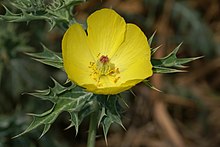Argemone mexicana
| Argemone mexicana | |
|---|---|

| |
| Scientific classification | |
| Kingdom: | Plantae |
| Clade: | Tracheophytes |
| Clade: | Angiosperms |
| Clade: | Eudicots |
| Order: | Ranunculales |
| Family: | Papaveraceae |
| Genus: | Argemone |
| Species: | A. mexicana
|
| Binomial name | |
| Argemone mexicana | |


Argemone mexicana, also known by the common names Mexican poppy,[1] Mexican prickly poppy, flowering thistle,[2] cardo, and cardosanto, is a species of poppy found in Mexico and now widely naturalized in many parts of the world. An extremely hardy pioneer plant, it is tolerant of drought and poor soil, often being the only cover on new road cuttings or verges. It has bright yellow latex. It is poisonous to grazing animals, and it is rarely eaten, but it has been used medicinally by many peoples, including those in its native area, as well as the indigenous peoples of the western United States, parts of Mexico, and many parts of India. In India, during the colorful festival Holika Dahan, adults and children worship by offering flowers, and this species is in its maximum flowering phase during March when the Holi festival is celebrated. It is also referred to as "kateli ka phool" in India.
Chemical constituents
[edit]
Argemone mexicana seeds contain 22–36% of a pale yellow non-edible oil, called argemone oil or katkar oil, which contains the toxic alkaloids sanguinarine and dihydrosanguinarine. Four quaternary isoquinoline alkaloids, dehydrocorydalmine, jatrorrhizine, columbamine, and oxyberberine, have been isolated from the whole plant of Argemone mexicana.[3] Many other alkaloids such as argemexicaines A and B, argemonine (N meth pavine),[4] Argepavine, O CH3 Argepavine, argemexirine, argenaxine, Argemexicaines A and B (protopine type), coptisine, cryptopine, allocryptopine and chelerythrine have also been found in this plant.[5]
The seed pods secrete a pale yellow latex when cut open. This argemone resin contains berberine and protopine.

Toxicity
[edit]
The seeds resemble the seeds of Brassica nigra (mustard). As a result, mustard can be adulterated by argemone seeds, rendering it poisonous. Several significant instances of katkar poisoning have been reported in India, Fiji, South Africa and other countries. The last major outbreak in India occurred in 1998. 1% adulteration of mustard oil by argemone oil has been shown to cause clinical disease.[6] In India, Argemone oil is mixed with sunflower oil and sesame oil to increase the quantity, but this adulteration causes health disorders and renowned brands display "no argemone oil" to qualify purity.[7]
Katkar oil poisoning causes epidemic dropsy, with symptoms including extreme swelling, particularly of the legs. All parts of plants are poisonous. Ingestion of them can cause perianal itching, pneumonia myocarditis and congestive cardiac failure, ascites, sarcoid-like skin changes, alopecia, hepatomegaly [8]
Traditional medicine
[edit]The Seri of Sonora, Mexico use the entire plant both fresh and dried. An infusion is made to relieve kidney pain post-natally.[9] When the Spanish arrived in Sonora, they called it cardosanto, taken as a laxative.[10] An Argemone mexicana tea is used in Mali to treat malaria.[11][12][13] In the traditional medicine of India, the yellow sap of A. mexicana and the whole plant may be used as a supposed treatment for jaundice.[14]
Other uses
[edit]Biodiesel production from A. mexicana seed oil using crystalline manganese carbonate has been demonstrated.[citation needed]
See also
[edit]References
[edit]- ^ BSBI List 2007 (xls). Botanical Society of Britain and Ireland. Archived from the original (xls) on 2015-06-26. Retrieved 2014-10-17.
- ^ Thomas C. Fuller (1986). Poisonous plants of California. University of California Press. pp. 201–. ISBN 978-0-520-05569-8. Retrieved 21 April 2013.
- ^ Singh, S.; Singh, T. D.; Singh, V. P.; Pandey, V. B. (February 2010). "Quaternary Alkaloids of Argemone mexicana". Pharmaceutical Biology. 48 (2): 158–160. doi:10.3109/13880200903062622. PMID 20645832.
- ^ "Argemonine".
- ^ Chang YC, Hsieh PW, Chang FR, Wu RR, Liaw CC, Lee KH, Wu YC (February 2003). "Two new protopines argemexicaines A and B and the anti-HIV alkaloid 6-acetonyldihydrochelerythrine from formosan Argemone mexicana". Planta Medica. 69 (2): 148–52. doi:10.1055/s-2003-37710. PMID 12624820. S2CID 260279102.
- ^ "Epidemic dropsy". WHO South East Asia Regional Office. Archived from the original on August 21, 2006. Retrieved 2006-11-17.
- ^ "What is argemone oil?". The Times of India. The Times of India. 31 August 2008. Retrieved 3 July 2016.
- ^ Abid Aqsa, Mushtaq Ahmad, Muhammad Zafar, Sadia Zafar, Mohamed Fawzy Ramadan, Ashwaq T. Althobaiti, Shazia Sultana, Omer Kilic, Trobjon Makhkamov, Akramjon Yuldashev, Oybek Mamarakhimov, Khislat Khaydarov, Afat O. Mammadova, Komiljon Komilov, and Salman Majeed (December 2023). "Foliar epidermal and trichome micromorphological diversity among poisonous plants and their taxonomic significance". Folia Horticulturae. 35 (2): 243–274. doi:10.2478/fhort-2023-0019. ISSN 2083-5965.
{{cite journal}}: CS1 maint: multiple names: authors list (link) - ^ Felger, R. S.; Moser, M. B. (1985). People of the Desert and Sea. Tucson, AZ: University of Arizona Press. ISBN 9780816508181.
- ^ Moore, M. (1990). Los Remedios: Traditional Herbal Remedies of the Southwest. Santa Fe, NM: Museum of New Mexico Press.
- ^ Merlin L Willco; Bertrand Graz; Jacques Falquet; Chiaka Diakite; Sergio Giani; Drissa Diallo (2011). "A "reverse pharmacology" approach for developing an anti-malarial phytomedicine". Malaria Journal. 10 (Suppl 1): S8. doi:10.1186/1475-2875-10-S1-S8. PMC 3059466. PMID 21411019.
- ^ Borrell, B. (2014-01-06). "Drug Developers Take a Second Look at Herbal Medicines". Scientific American. 310 (6): 64–9. doi:10.1038/scientificamerican0614-64. PMID 25004577.
- ^ Willcox, M. L.; Graz, B.; Falquet, J.; et al. (2007). "Argemone mexicana Decoction for the Treatment of Uncomplicated Falciparum Malaria" (PDF). Transactions of the Royal Society of Tropical Medicine and Hygiene. 101 (12): 1190–1198. doi:10.1016/j.trstmh.2007.05.017. PMID 17920092.
- ^ Tewari D, Mocan A, Parvanov ED, Sah AN, Nabavi SM, Huminiecki L, Ma ZF, Lee YY, Horbańczuk JO, Atanasov AG (2017). "Ethnopharmacological Approaches for Therapy of Jaundice: Part I". Frontiers in Pharmacology. 8: 518. doi:10.3389/fphar.2017.00518. PMC 5559545. PMID 28860989.
{{cite journal}}: CS1 maint: multiple names: authors list (link)
External links
[edit]- Dressler, S.; Schmidt, M. & Zizka, G. (2014). "Argemone mexicana". African plants – a Photo Guide. Frankfurt/Main: Forschungsinstitut Senckenberg.
